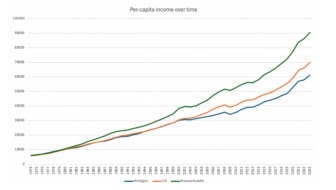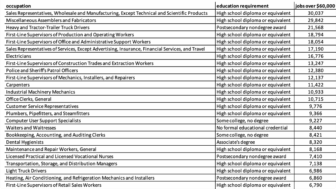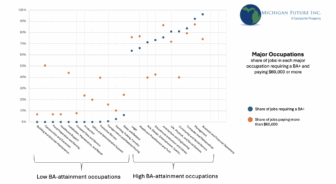Last fall, we released our proposal for a Working Parents Tax Credit (WPTC) here in Michigan. As the name suggests, this new refundable tax credit would be targeted to working parents with young children, sending $5,000 to EITC-eligible households for each child under three years old, and $2,500 for each child between the ages of three and five. The motivation for the WPTC is to help working parents with young children defray the high cost of childcare, as well as combat the so-called benefit cliff, in which public assistance declines as individuals earn more from work.
In the months since we’ve unveiled our proposal, we’ve met with a number of stakeholders across sector and ideology, many of whom have been quite supportive. People of all political persuasions are committed to helping working parents pay for childcare and stabilize household finances as they take on a new job or more hours at work.
The first question everyone asks, however, is how we would pay for it.
It’s a legitimate question. We estimate the WPTC would cost a billion dollars. Is this something the state can afford?
Our answer is yes, but only if we shift how we think about the kind of state investments that will have the greatest impact on the greatest number of hardworking Michigan families. In short, we argue that these investments should emphasize income over programs.
The income over programs orientation
Most policymakers, when confronted with a problem faced by their constituents, will try to devise a program to help combat that problem. This is true not just in Michigan, but in state legislatures across the country and at the federal level as well. This is why our social policy landscape is marked with a patchwork of different programs, each designed to serve a different need. There is food assistance to help low-income households obtain sufficient food; workforce development programs to help the unemployed find or train for a new job; childcare vouchers to help working families obtain care.
What there is a lot less of, is cash – a flexible resource that can be used for a variety of purposes. The answer to most of the problems faced by resource-constrained households is, predictably enough, more money. However, over the years policymakers have collectively decided that non-affluent families cannot be trusted with cash alone. The thinking goes that giving non-affluent households cash will dampen the motivation to work, or that individuals will use the cash not for basic necessities, but for cigarettes, alcohol, and non-essentials. This is why we have ended up with a patchwork of paternalistic programs: food assistance for food; housing assistance for housing; childcare assistance for childcare, etc.
There are a number of problems with this arrangement. But two primary ones have to do with problems of scale and flexibility. And we’ve designed the Working Parents Tax Credit specifically to combat these issues.
Let’s look at a concrete example: our state’s childcare subsidy system. The childcare subsidy system provides a great example for how a well-intentioned program falls short of achieving its ultimate goal – helping parents pay for childcare, at scale – and how cash, provided by a mechanism like the WPTC, could do a much better job.
The state’s childcare subsidy system, known as the Child Development and Care program, helps defray the cost of childcare for eligible families by providing payments directly to childcare providers. In any given month, roughly 30,000 children benefit from the state’s childcare subsidy system. However, we estimate there are more than 250,000 children under the age of 6 in Michigan who would qualify for the subsidy based on household income, meaning the subsidy system covers only a small fraction of eligible children (the number of eligible children is actually far larger, since children up to age 12 are eligible for a subsidy, but for this exercise we’re excluding children ages six and up).
Why doesn’t the CDC program cover more children? In recent years Michigan’s childcare subsidy system has been propped up by expanded federal relief dollars, but in normal times the state receives a Child Care and Development block grant from the federal government worth roughly $220 million which, combined with state matching funds of roughly $20 million, funds the state’s subsidy system. $240 million may seem like a lot of money, but it doesn’t get very far in covering the cost of childcare. If we assume the cost of full-time high-quality childcare is roughly $12,000 per year, and the full budget were expended only on subsidies, this would cover just 20,000 children. The subsidy system generally covers more kids by providing smaller subsidies for providers, though this leaves larger out of pocket expenses for parents who need care, while still only covering a small fraction of eligible kids.
But overall program funding is only one of the reasons why the CDC program covers so few eligible children. The others have to do with all the complications inherent to running a program. First, in order to use a childcare subsidy a parent needs to find an eligible provider, which can be a challenge in the many parts of the state that are defined as “childcare deserts,” with too few providers to serve the number of kids in the area. Reports and interviews suggest the system is administratively burdensome both for parents and for providers, which may also dampen participation. And eligibility rules, such as the requirement that parents be working prior to applying for care may present a “catch-22” for many unemployed parents, in which they are unable to procure the care they need in order to go look for a job.
Contrast how this program functions with the design of the Working Parents Tax Credit. In our proposal, all households who qualify for the Earned Income Tax Credit (which has an income limit roughly aligned, and in some cases a bit higher than the income eligibility limits for the CDC program), have a child under 6, and have employment earnings of at least $10,000 would qualify for the Working Parents Tax Credit. Parents would not have to fill out any burdensome paperwork to receive the additional credit. While roughly 30,000 children receive support from the state’s childcare subsidy system, we estimate roughly 250,000 children would benefit from the Working Parents Tax Credit. Parents could use the money to pay for care if they chose to do so, but they could also dedicate the additional resources to whatever was the most pressing need for their household. And while the supply of childcare providers would still be an obstacle to obtaining care, with cash parents would not have to find an eligible provider who participates in the subsidy system, but could also find more informal care, perhaps through a family member. If they did use the funds to pay for care through a licensed provider, while the WPTC would not cover the full cost of care, it would meaningfully defray the cost of care for tens of thousands more families than are currently covered under the subsidy system.
It’s worth noting that the contrast outlined here between the subsidy system and the Working Parents Tax Credit isn’t a tradeoff that’s on the table – as previously mentioned, the subsidy system is largely paid for through a federal grant that is dedicated towards supporting the subsidy system, and isn’t going anywhere. Nor should it. We need all the resources we can get to help working families pay for childcare. The point, rather, is to outline the differences between programs versus cash more generally. And to note that there are many other programs we can look to that carry with them the same flaws as the childcare subsidy system – small scale, burdensome application process, limited flexibility – and that if eliminated could help pay for the Working Parents Tax Credit, a program that would help the vast majority of non-affluent working parents with young children pay for the necessities, including child care.
The enduring myths about unrestricted cash
Finally, what about the common critiques of unrestricted cash, outlined above. Are we worried that unrestricted cash supports will reduce recipients’ motivation to work? Or that they’ll use the money unwisely?
When the expanded child tax credit was rolled out in July of 2021, many fretted that we would see significant declines in labor market participation, with workers reducing their work effort because of the new influx of cash. However, research from Columbia University’s Center on Poverty and Social Policy found no employment effects in response to the policy, one of the most generous cash-based policies in U.S. history. Indeed, while economic theory suggests recipients of cash will reduce their work effort, empirical data regularly tells a different, and more complicated story. Some research suggests for those with lower incomes, the receipt of unrestricted cash will actually have a positive impact on labor force participation and work effort, because the cash helps to ease “liquidity constraints” (e.g., being able to pay for childcare) that may have previously reduced that recipients work hours.
In addition, despite supposed fears that recipients will misuse unrestricted cash, research suggests the vast majority of households who receive cash assistance spend the money on exactly what they need to spend it on, given their unique circumstances. In the words of Sam Hammond, an analyst at the libertarian leaning Niskanen Center, “the flexibility of cash is a feature, not a bug.” Research on how households spent their expanded child tax credit payments suggests “families utilized the CTC payments to enhance the well-being of both their children and the entire household,” spending most of the cash on food, housing, and “child-related goods and services.” Earlier research on how families spend their Earned Income Tax Credit payments found that families often spent the influx of cash on relatively expensive investments (e.g., a car) that contributed to their economic mobility and that they would not have otherwise been able to afford. Finally, research suggests that counter to the idea that recipients will spend the unrestricted cash on cigarettes and alcohol, so-called “vice spending” actually declines when families receive cash supports. Why? One likely explanation is that because the additional cash helps to relieve stress (a well-established outcome of nearly all research on the impacts of cash aid), the recipient is less likely to rely on other means of stress relief, such as nicotine and alcohol.
For far too long non-affluent families have received very little of the support they need most from their government: a bit of extra cash. Instead, they’ve been met with narrowly defined programs that are often cumbersome, difficult to access, and dramatically under resourced. By shifting more of our public support for non-affluent working households to cash instead of programs, we can more effectively support many more families, at scale, with whatever it is their individual family needs help with. Something I think we can all agree is money well spent.







